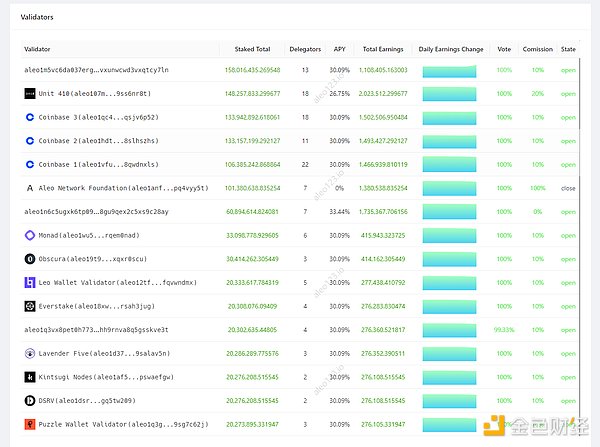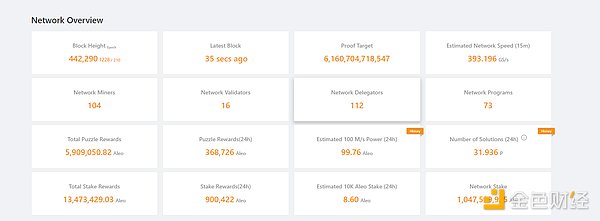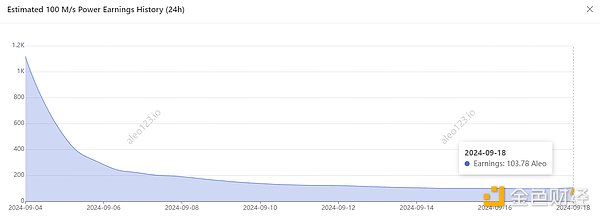Author: Frank, PANews
As a star project with more than 200 million US dollars in financing, the progress of Aleo has always attracted much attention. On September 18, 2024, Aleo's mainnet was officially launched, and the token economics was finally disclosed. However, after the mainnet was launched, Aleo failed to gain community recognition. Instead, it was full of doubts on social media, especially from miners. Many users said on social media that this was another failed case of a king turning into a "death".
Star project with full buffs
Founded in 2019, Aleo proposed to build a privacy-protecting, permissionless and programmable platform from the beginning. The official introduction of its main technologies includes simple proof of work (PoSW), Leo language, AleoBFT, Varuna and other contents. These technologies mainly build an L1 blockchain network with privacy protection as the core, through zero-knowledge proof technology, combined with POW, POS, and AleoBFT consensus mechanisms. From the perspective of comprehensive technical characteristics, Aleo is more like an L1 blockchain network that integrates the consensus mechanisms of Ethereum and Solana, and is also supported by zero-knowledge technology.
The background of the founding team members of Aleo is also a standard academic school. The main members are from the University of California, Berkeley, and have also worked for well-known Silicon Valley companies such as a16z, Coinbase or Amazon. The star team and innovative concepts have made Aleo's financing smooth. In 2021, it received US$28 million in Series A financing, and in 2022, it completed US$200 million in Series B financing, with a valuation of US$1.45 billion. The lineup of investors is also well-known institutions such as a16z, Softbank, Kora, and Coinbase.
However, the development progress of the Aleo team seems to be a bit slow. The final version of the testnet was not launched until May 2024. The mainnet was announced to be launched as early as 2023, and the mainnet that was planned to be launched in January 2024 was delayed to September. In this process, Aleo missed the bonus period of the project's rise in the early stage of this bull market, and also made the miners who participated in the early stage waiting for rewards suffer.
It can be said that whether from the team background, technical concepts or investor lineup, Aleo is full of buffs. If it were not for the slow launch speed, it might have already ranked among the ranks of the first-tier new public chains.

Since the official data platform of Aleo does not display the specific number of wallet addresses and daily transactions, the specific ecological activity of Aleo cannot be verified by direct data. The ecological development of Aleo can only be speculated through some other data.
Puzzle wallet is the most called program on Aleo. On September 19, Puzzle was called more than 10,000 times, achieving explosive growth. From the perspective of the time node, this may be due to Aleo’s announcement on September 18 that airdrop tokens can be claimed through the Puzzle wallet. Before that, the number of calls to programs on Aleo in a single day did not exceed 100. According to official publicity from Puzzle, the wallet currently has more than 30,000 users.

Aleo founder Alex Pruden said on social media when celebrating the launch of the mainnet: "This achievement would not have been possible without the efforts of dozens of employees, hundreds of ambassadors and thousands of community members." Judging from the above data, Aleo's ecological activity is not high. However, the number of Aleo's ecological projects is still considerable. As of now, there are more than 50 projects in the Aleo ecosystem.
Airdrop lock-up, price plunge causes double blow to miners
Although the mainnet has been delayed, Aleo's financing of more than 200 million US dollars is still imagined as a potential stock by various mining studios and miner groups. Well-known mining pools including Bitmain and Fish Pool have also launched mining services for Aleo test coins early. Therefore, many miners have also invested their computing power in pre-mining.
According to the official browser of Aleo, the Aleo mainnet has been launched on September 5, but the official has not announced this news. Some miners who smelled business opportunities have also begun to deploy mining. The over-the-counter price of the first produced tokens was close to US$9, and the official did not announce the launch of the mainnet until September 18. This wave of operations has also aroused a lot of suspicion in the community. Some people think that the official is taking advantage of this time to pre-mine tokens or leave time for VC to pre-mine.
A miner who participated in the early mining of Aleo told PANews that they did not dare to deploy too much computing power because they were not sure whether the mined tokens would be officially recognized. However, in early September, many over-the-counter merchants in the community began to purchase Aleo tokens at a price of around $9. Based on the price of 1.5 tokens generated by a 4090 a day, the daily income is about $13.5, and it will take about 158 days to recover the graphics card investment. If the price of Aleo rises to $20, the graphics card investment may be recovered within three months. Therefore, Aleo's profit expectations make many miners full of expectations.
However, this situation changed dramatically after the official announcement of the token economics on September 16. According to Aleo, the initial supply of Aleo tokens reached 1.5 billion, and will increase to 2.6 billion within ten years with mining activities. Based on this $9, Aleo's initial market value will reach $13.5 billion, which means that Aleo may become one of the top ten crypto projects, surpassing public chain tokens such as TRON and ADA that have been developed for many years.
For a project with only tens of thousands of addresses of ecological users, this market value expectation is obviously too high. Therefore, the price of Aleo has taken a big dive since the announcement of the token economics, and has fallen to $3.4. As of September 20, Aleo's market value is about $5 billion, which can also rank among the top 20 crypto market capitalizations.
However, the sudden price plunge has caused a sharp drop in miners' income, and the payback period may be extended to 10 years if the costs of electricity and network are included.
In addition, for miners who participated in the test network in the early stage, they will receive incentives from Aleo. According to the official introduction, 34% of Aleo tokens will be used to reward early supporters. However, this reward cannot be cashed in immediately. The official policy states that the rewards for US and non-US users (quite in the style of Lu Xun's description of "There are two jujube trees in my backyard") have a one-year lock-up period. As soon as this news came out, early miners who were eager to recover their costs could only silently bear the backstab from the official again.
Interestingly, Aleo, which aims to build a privacy-first blockchain, stated that all users need to complete KYC when applying for airdrops, and required users who applied to upload their identity documents, proof of address and selfies. This requirement also caused strong dissatisfaction in the community.
Capital first to recover? Community doubts continue
According to the latest information from Aleo, becoming a mainnet validator requires at least 10 million Aleo tokens. For most ordinary users, this amount of funds and tokens (there may not be so many circulating tokens in the market in the early stage) are almost impossible to achieve. Some users have noticed that when the Aleo mainnet was launched, 16 validators had already started running, and most of these validators were early investors.
Although the circulation of investors' tokens is also locked for one year, they can directly convert the locked tokens into the validator's staked tokens. At the same time, there is no lock-up period for the daily reward tokens of the stake, and they can be circulated at any time.
As of September 20, data shows that the largest number of validators has obtained more than 1.1 million Aleo tokens, and the smallest number of validators has obtained more than 270,000. Among the validators, investors or project-related institutions such as Coinbase, unit410, and Aleo Foundation account for the majority.


Many community users believe that the project party's operation has the problem of letting the capital return first, and then letting retail investors take over the mined tokens. Miners who pay out of their own pockets have to weigh the payback period of electricity bills, equipment and other costs.
From the perspective of mining revenue changes, before the announcement of the token economics, the mining difficulty of Aleo increased exponentially. After the announcement of the token economics, perhaps because many miners withdrew, the mining difficulty began to decrease.

On social media, the evaluation of Aleo also changed from recommendation to questioning. Twitter user @alexlizeros said: "From this death-level project ALEO, we can see that sometimes a large project does not bring benefits, but brings greater losses!". After KOL @Supervellear posted a tweet questioning Aleo, he was blocked by Aleo founder Alex Pruden's social media. @alexlizeros listed Aleo’s doubts about the delay of the mainnet, airdrop lock-up, and excessive market value in his tweet, and concluded: “When you don’t know where the liquidity comes from, you are the liquidity.”
So far, Aleo officials have not responded to the community’s many questions. However, judging from the current social media trends and token performance, if Aleo wants to regain the market’s confidence in it, it may need to give a more reasonable explanation and more practical sincerity.
 JinseFinance
JinseFinance
 JinseFinance
JinseFinance JinseFinance
JinseFinance Wilfred
Wilfred Cheng Yuan
Cheng Yuan XingChi
XingChi Wilfred
Wilfred JinseFinance
JinseFinance Sanya
Sanya Coindesk
Coindesk Bitcoinist
Bitcoinist